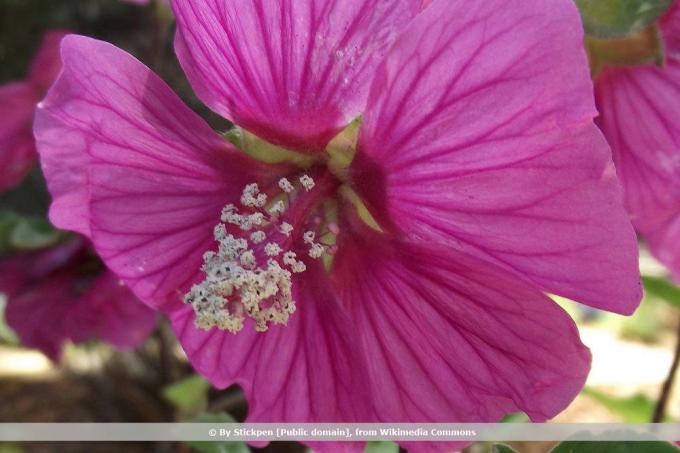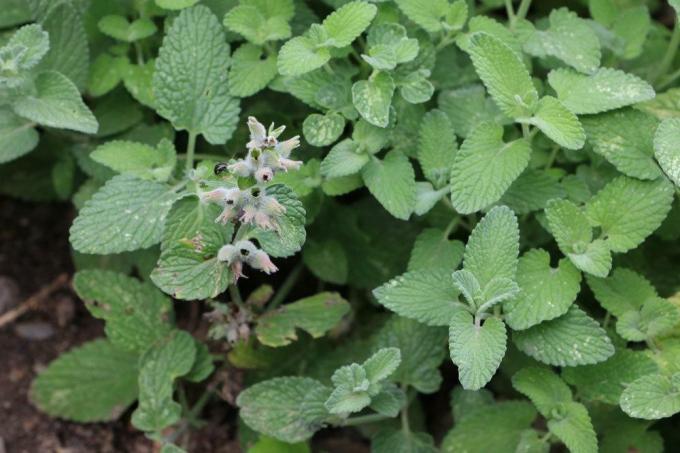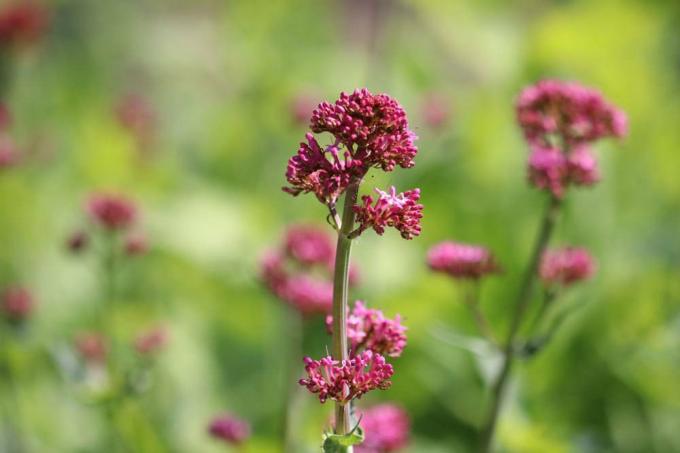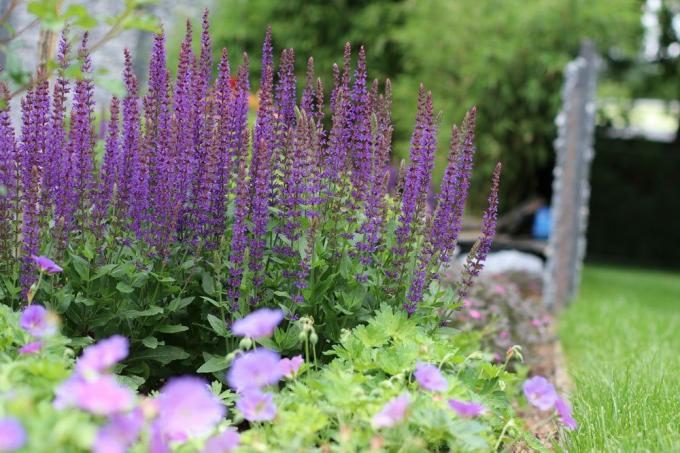
table of contents
- Hardy permanent bloomer
- from B - G
- from I - K
- from O - R
- with S
Flowers that bloom for a long time and thus make the perennial bed look attractive throughout the summer should not be missing in any garden. On the following list we present the 14 most beautiful permanent bloomers that are also hardy and will delight you for so many years.
Hardy permanent bloomer
Geraniums, petunias and begonias are the classics among permanent flowers in pots and in the garden. However, these plants are not hardy and therefore have to be moved to a protective winter quarter every year or bought new in the spring. Instead, simply plant perennials that winter cannot harm - and enjoy their annual abundance of flowers. The following 14 permanent bloomers form new, magical flowers over the course of weeks and months and, as reliable nectar suppliers, also delight many useful insects.
from B - G
Bush mallow (Lavatera x olbia)
The bush mallow with its large, beautiful white-pink flowers blooms tirelessly throughout the summer. The undemanding perennial does not need a lot of care, but winter protection in winter. Cut them back in late fall and cover them with leaves and sticks.
- Height: 80 to 120 centimeters
- Growth habit: bushy
- Flower: cup-shaped
- Flower colors: white, pink, purple
- Flowering period: July to October
- Location: sunny
- Soil: moderately rich in nutrients
- Popular varieties: 'Baby Barnsley', 'Barnsley'
- Special features: requires a lot of space, 70 to 80 centimeters plant spacing

Scented nettle (Agastache rugosa)
The Asian scented nettle comes from East Asia, where it is mainly found in river valleys. The very easy-care, perennial, permanent bloomer is hardy and resistant to diseases and pests.
- Height: 40 to 50 centimeters
- Growth habit: bushy
- Flower: panicle-shaped
- Flower colors: purple, pink, white
- Flowering period: July to September
- Location: sunny
- Soil: sandy-humic, dry
- Popular varieties: 'Serpentine', 'Alabaster', 'Black Adder', 'Blue Fortune'
- Special features: bee-friendly

Large-flowered maiden's eye (Coreopsis grandiflora)
The large-flowered (also: large-flowered) girl's eye is one of the perennial types of girl's eyes. In addition, the species is one of the flowers that bloom particularly profusely and for a long time, because its bright yellow shell flowers can be admired from early summer to autumn. After flowering, it should be cut back completely in order to shine in new beauty in spring.
- Height: depending on the variety between 30 and 70 centimeters
- Growth habit: clumpy
- Flower: cup-shaped
- Flower colors: yellow, two-tone yellow-red
- Flowering period: June to September
- Location: sunny
- Soil: fresh, sandy-humic
- Popular varieties: 'Sunray', 'Christchurch', 'Heliot', 'Early Sunrise', 'Sonnenkind'
- Special features: very easy to care for

from I - K
Iceland poppy (Papaver nudicaule)
This colorful flowering poppy species may like it sunny, but - as the name suggests - not too warm. The pretty permanent bloomer shows its splendor all summer long and should therefore not be missing on this list. In addition, you do not have to overwinter the easy-care flower because it is short-lived. If you only leave a few withered specimens, they will seed themselves all by themselves - and the Icelandic poppy will return in undiminished splendor the following year.
- Height: 20 to 25 centimeters
- Growth habit: cushion-like
- Flower: cup-shaped
- Flower colors: yellow, orange, red
- Flowering period: May to September
- Location: sunny
- Soil: well drained, low in lime
- Popular varieties: 'garden gnome'
- Special features: valuable bee pasture

Catnip (Nepeta)
Is catnip only for cats? Certainly not, even if the four-legged friends find this intensely fragrant plant extremely attractive. The easy-care and robust plant also cuts a fine figure in the perennial garden, as it is also one of the flowers that bloom long and profusely.
- Height: 60 to 80 centimeters
- Growth habit: bushy, clumpy
- Flower: panicle-shaped
- Flower colors: blue-violet
- Flowering period: June to August
- Location: sunny
- Soil: well drained, humic
- Popular varieties: 'Zinser's Giant', 'Pool Bank', 'Bramdean', 'Blue Danube'
- Special features: valuable bee pasture, very popular with cats

tip: In addition to the species presented here, the blue catnip (Nepeta x faassenii), the veined ones, are also suitable Catnip (Nepeta nervosa) as well as the grape catnip (Nepeta racemosa) are very good for the hardy Perennial garden.
Cockade flower (Gaillardia x grandiflora)
The large-flowered cockade flower shows its striking yellow-red pods between July and September. If you cut away what has faded as soon as possible, the distinctive perennial will develop a no less attractive second bloom and decorate it Perennial bed so until autumn.
- Height: 40 to 50 centimeters
- Growth habit: upright, clumpy
- Flower: cup flower
- Flower colors: red, two-tone yellow-red
- Flowering period: July to September
- Location: sunny
- Soil: well drained, rich in nutrients
- Popular varieties: 'Fackelschein', 'Bremen', 'Burgunder', 'Kobold', 'Arizona Sun'
- Special features: suitable as a cut flower, bee pasture

from O - R
Ox-eye (Buphthalmum salicifolium)
This attractive perennial is also known as "gold marguerite" for a reason, as its numerous flowers are reminiscent of those of the marguerite - only in a bright yellow shade. The permanent bloomer is very hardy and otherwise extremely robust against diseases and pests.
- Height: 40 to 50 centimeters
- Growth habit: bushy
- Flower: radial
- Flower colors: yellow
- Flowering period: June to August
- Location: sunny
- Soil: well-drained, dry to fresh, calcareous
- Special features: bee-friendly

Magnificent candle (Gaura lindheimerii)
These flowers really bloom for a very long time: from early summer until well into autumn, splendid candles show their pretty rows of blossoms. The white flower bowls hang loosely in clusters on the perennial and attract numerous insects. However, the splendor candle is only partially hardy and therefore needs winter protection. The pruning should be done in late autumn.
- Height: 80 to 100 centimeters
- Growth habit: bushy
- Flower: cup-shaped
- Flower colors: white, pink
- Flowering period: June to October
- Location: sunny
- Soil: well drained, humic
- Popular flavors: 'Siskiyou Pink', 'Whirling Butterflies'

Red coneflower (Echinacea purpurea)
Botanically correct, this perennial is the purple sun hat, which is also known as a medicinal plant under its Latin name Echinacea. In the bed, this very long blooming beauty shows numerous large ray flowers in bright colors, which form a wonderful contrast to the dark green, rough leaves. The plant should be cut back vigorously in late autumn and will come back reliably in the following year.
- Height: 80 to 100 centimeters
- Growth habit: upright, clumpy
- Flower: radial, large
- Flower colors: pink, pink, red
- Flowering period: July to September
- Location: sunny
- Soil: loamy-sandy, well-drained, fresh
- Popular varieties: 'Leuchtstern', 'Cheyenne Spirit', 'Hot Lava', 'Doppeldecker', 'Eccentric'
- Special features: bee-friendly, medicinal plant

with S
Yarrow (Achillea millefolium)
The yarrow has also been a medicinal plant that has been known for centuries and is widespread in Central Europe. Not only is it one of the particularly robust and easy-care flowers in the perennial bed, it is also extremely hardy. Apart from the very vigorous wild form, there are now numerous red or pink flowering cultivars that get along wonderfully with many other perennials in the bed.
- Height: 30 to 50 centimeters
- Growth habit: upright
- Flower: umbel-shaped
- Flower colors: white, pink, orange, red
- Flowering period: June to August
- Location: sunny
- Soil: rich in humus, fresh, moderately acidic to neutral
- Popular varieties: 'Lilac Beauty', 'Schneetaler', 'Kirschkönigin', 'Saucy Seduction', 'Summer Fruits Carmine', 'Paprika', 'Terracotta'
- Special features: spreads strongly over rhizome runners, bee-friendly, medicinal plant

tip: Yarrows should be divided about every two to four years, as this counteracts aging and promotes the flowering.
Summer Marguerite (Leucanthemum x superbum)
With their bright white flowers - filled or unfilled depending on the variety - summer daisies are the stars in the flowerbed. The pleasantly uncomplicated and easy-care perennials are cut back to just above the ground in autumn so that they sprout again vigorously in the coming spring. The vigorous plants should also be divided about every two to four years in order to maintain their flowering power.
- Height: between 40 and 100 centimeters, depending on the variety
- Growth habit: upright. clumpy
- Flower: radial
- Flower colors: white
- Flowering period: July to August
- Location: sunny
- Soil: well-drained, fresh, rich in nutrients
- Popular varieties: 'Polaris', 'Silver Princess', 'Wirral Supreme', 'Alaska', 'Paladin', 'Victorian Secret', 'Eisstern'
- Special features: valuable bee pasture

Sun bride (Helenium x cultorum)
"Sun bride" - what a picturesque name! Indeed, these flowers, which incidentally, feel tireless all summer and into autumn bloom and should therefore not be missing from the list of permanent bloomers, especially in a sunny location well. Here, their bright flower colors come into their own particularly impressively. Cut the attractive perennial back before autumn, but not down to the ground: it It is sufficient to cut out the faded stems and possibly to enlarge the width of the plant restrict.
- Growth height: depending on the variety up to 120 centimeters
- Growth habit: upright, clumpy
- Blossom: cup-shaped, large
- Flower colors: yellow, red, brown-red, two-tone yellow-red
- Flowering period: June to September
- Location: sunny
- Soil: well-drained, fresh to moist, rich in nutrients, loamy
- Popular varieties: 'Indian summer', 'Baudirektor Linne', 'Biedermeier', 'Flammenrad', 'Goldrausch', 'Herbstgold'
- Special features: also very suitable as a cut flower

tip: Sonnenbraut goes well with asters and roses in the bed.
Spurflower (Centranthus ruber)
Another permanent bloomer is the pretty spur flower with its numerous cymes. It does best in a warm and sunny place. The soil is ideally chalky and rather dry - because too much moisture acknowledges the otherwise easy-care plant with poor growth and diseases. Cut off dead shoots in good time so that the perennial continues to develop new flowers. In addition, the plant has a strong tendency to self-seed, so that you counteract uncontrolled reproduction in this way.
- Height: 40 to 60 centimeters
- Growth form: upright, clump-forming
- Flower: umbel-shaped, small
- Flower colors: white, carmine pink
- Flowering period: June to August
- Location: sunny
- Soil: slightly dry, well-drained, calcareous
- Popular varieties: 'Albus', 'Coccineus'
- Special features: also very suitable for a pot culture

Steppe Sage (Salvia nemorosa)
This species, also known as flowering sage, is a welcome inhabitant of the perennial bed: Easy to care for, very robust and extremely hardy, the abundant flowering plant presents itself to many Years. But not only people are delighted by the pretty corn blossoms, bees, butterflies, bumblebees and other insects cavort on these valuable pasture plants. Thus, the steppe sage helps to keep the natural balance in the garden.
- Height: depending on the variety between 30 and 50 centimeters
- Growth habit: bushy, upright, clump-forming
- Flower: spike-shaped
- Flower colors: purple, pink, white
- Flowering period: June to September
- Location: sunny
- Soil: calcareous, dry to fresh, well-drained
- Popular varieties: 'Caradonna', 'Ostfriesland Kompakt', 'Pusztaflamme', 'Rügen', 'Sensation White', 'Viola Klose', 'Jan Spruyt'
- Special features: bee-friendly


